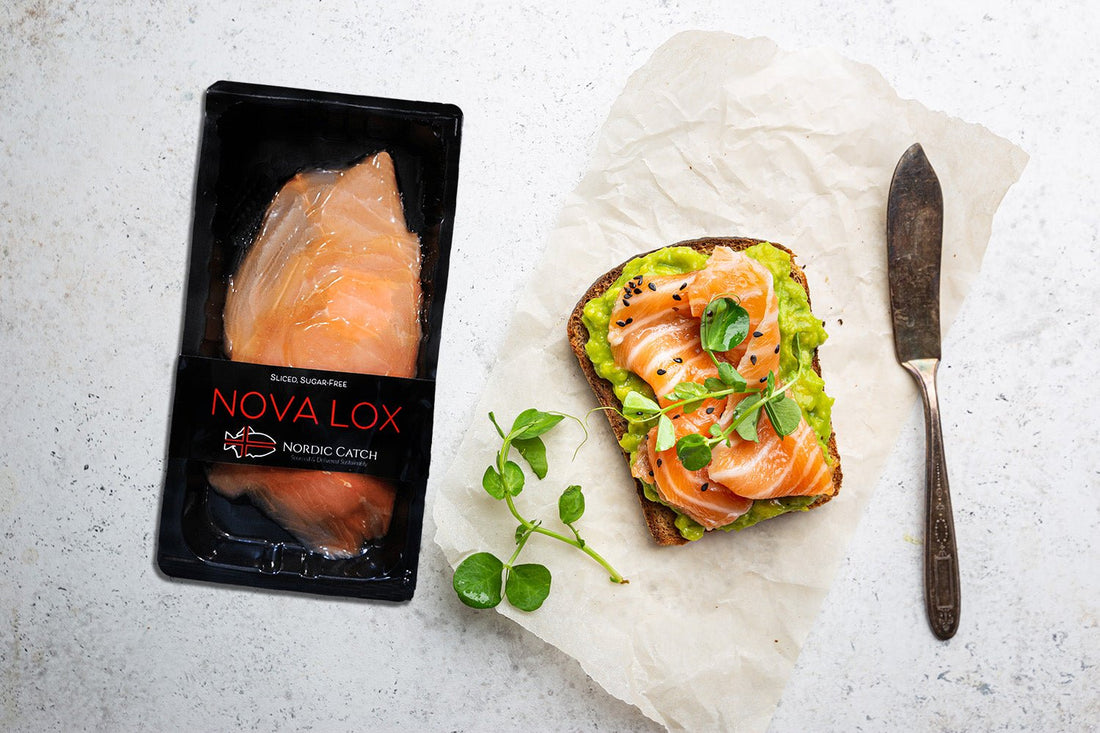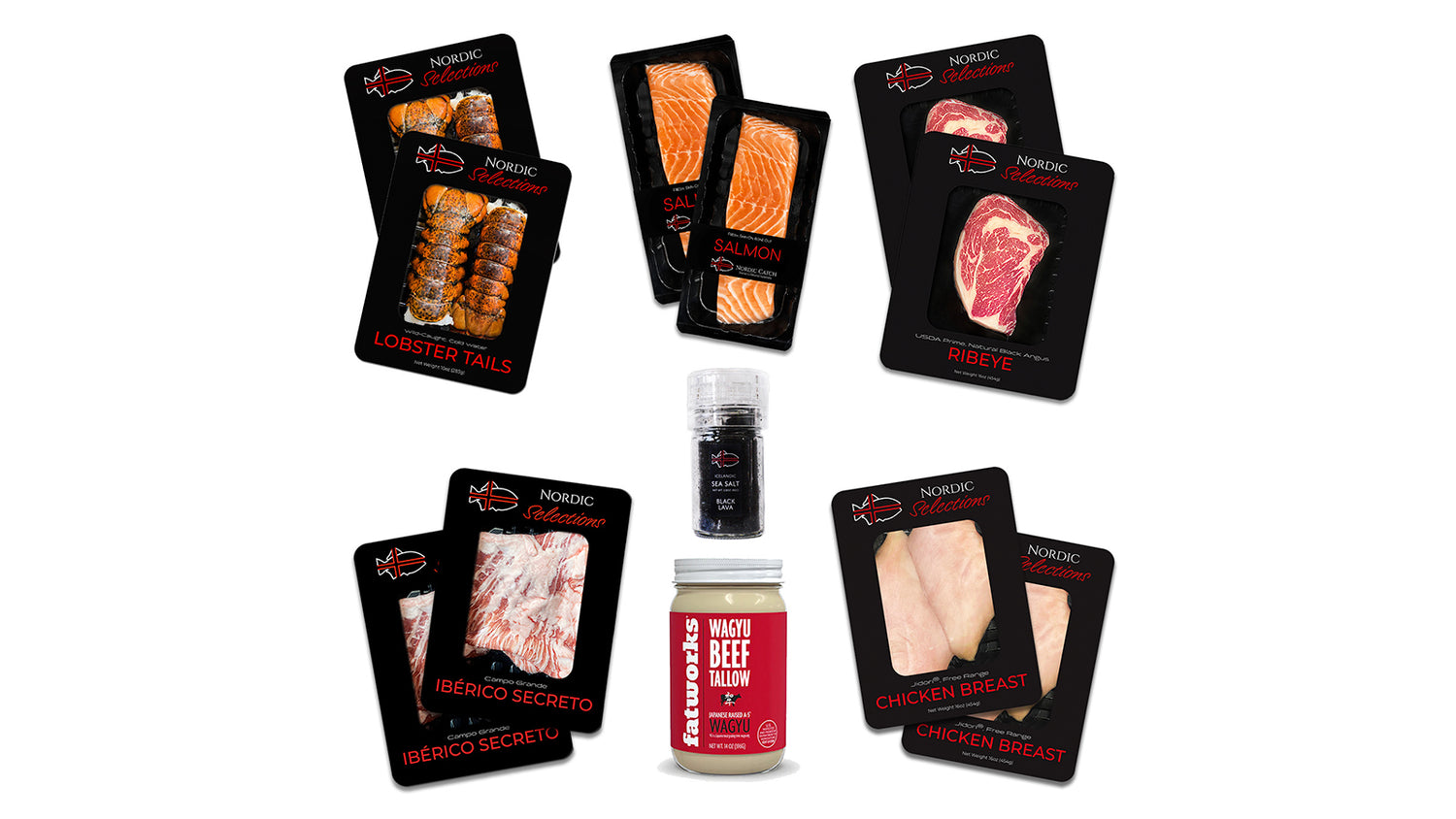
6 of the Best Ways to Cook Salmon
Salmon is a superstar in the kitchen, a versatile ingredient that often works for everyone. You can bake, grill, broil, or poach it—each method brings unique flavors and textures. If you buy fish in bulk, it's even easier to experiment with these techniques and always have salmon ready to cook. Let us look at several of the best ways to cook salmon.
6 of the Best Ways to Cook Salmon
Salmon is one of the healthiest seafoods in the market. We've tried and tested the best ways to cook salmon. Each method contains different textures and flavors, so the right choice depends on your mood and how you cook.
1. Baking Salmon
Baking salmon is an easy and foolproof method you can count on, whether you're just starting out or already confident in the kitchen. This method allows the fish to cook evenly while preserving its natural moisture, giving you a tender, flavorful result every time.
For the best results, go for sushi-grade salmon to enjoy tender, flavorful bites every time. With fish delivery services, you can keep your favorite salmon cuts on hand, ready to bake whenever you want a delicious and nutritious meal.
Cooking Time
- 12-15 minutes for fillets at 400°F (204°C).
- 15-20 minutes for larger cuts at 350°F (176°C).
The Method
- Preheat your oven to the recommended temperature.
- Place the salmon on a foil-lined baking sheet for easy cleanup.
- Season with salt, pepper, and your choice of herbs or marinades.
- Bake until the salmon becomes opaque and flakes easily with a fork.
Tips: Add lemon slices or a drizzle of olive oil before baking for moist and flavorful results. For a healthier option, use parchment paper instead of foil. Always check the doneness at the thickest part of the fillet with a fork or thermometer to avoid overcooking.
Benefits: Baking is a low-maintenance cooking method that preserves the salmon's natural oils and nutrients. It's perfect for meal prep, as you can bake multiple portions simultaneously. Plus, it allows for easy flavor customization with marinades and herbs.
2. Pan-Searing Salmon
If you love crispy skin and tender, flaky salmon, pan-searing is the way to go. This quick cooking method brings out the fish's natural flavors and creates a restaurant-quality finish at home. Make your seafood box with fresh salmon fillets and other favorites to keep your meals exciting.
Cooking Time
- 4-5 minutes skin-side down, followed by 2-3 minutes on the other side.
The Method
- Pat the salmon dry with a paper towel to remove excess moisture.
- Heat a skillet over medium-high heat and add a high-smoke-point oil like avocado or grapeseed.
- Place the salmon skin-side down and cook without moving it for 4-5 minutes.
- Flip the salmon and cook for another 2-3 minutes until the flesh is opaque.
Tips: Ensure the salmon is dry before cooking to achieve perfectly crispy skin. Use a non-stick skillet to prevent sticking and avoid overcrowding the pan for even heat distribution. Please don't press the salmon while cooking; this can release its natural juices and dry it.
For pan-searing salmon, use oils with high smoke points, such as avocado, grapeseed, or canola oil. These oils can withstand high temperatures without burning.
Benefits: Pan-searing delivers a golden, crispy exterior while keeping the inside moist and tender. This method is quick and ideal for your weeknight meals. It also boosts the salmon's natural flavor, requiring minimal seasoning to shine.

3. Grilling Salmon
Grilling salmon is perfect for adding a smoky flavor and a charred finish. This method is ideal for summer barbecues or elevating your smoked salmon dish with bold outdoor flavors.
Cooking Time
- 6-8 minutes per side for fillets.
- 10-12 minutes total for thinner cuts or smaller portions.
The Method
- Preheat the grill to medium-high heat.
- Brush the salmon with oil and season with salt, pepper, and optional marinades.
- Place the salmon skin-side on the grates and cook for 6-8 minutes without flipping.
- Flip carefully using a fish spatula and cook for another 4-6 minutes.
Tips: Clean and oil the grill grates thoroughly before cooking to prevent sticking. Allow the salmon to form a crust before flipping to avoid tearing. Grill the salmon on a cedar plank for added flavor and easier handling.
Benefits: Grilling imparts a smoky flavor and creates beautiful grill marks, improving the presentation and taste. It's ideal for firmer varieties like Sockeye or King salmon, which retain their texture on the grill.
4. Poaching Salmon
Poaching is a gentle, low-fat cooking method that produces tender, moist results. Salmon is among the highest-protein seafood, and poaching can preserve that quality. It's an excellent choice for light meals or when you want to highlight the fish's natural flavors.
Cooking Time
- 8-10 minutes in simmering liquid.
The Method
- Fill a shallow pan with water, fish stock, or white wine, and add aromatics like lemon slices, bay leaves, and fresh herbs.
- Heat the liquid to a gentle simmer, avoiding a rolling boil.
- Submerge the salmon and cook for 8-10 minutes until it flakes easily.
Tips: Keep the liquid at a steady simmer rather than boiling to prevent overcooking. Use flavorful poaching liquids to infuse the salmon with subtle, complementary flavors. Ensure the salmon is fully submerged for even cooking.
Benefits: Poaching is a healthy, low-calorie method that results in delicately cooked salmon. It pairs well with salads, grains, or light sauces, making it a versatile option for balanced meals.

5. Broiling Salmon
If you're short on time but want a caramelized crispy finish, broiling is your go-to method. This high-heat technique delivers quick and flavorful results.
Cooking Time
- 5-7 minutes under high heat.
The Method
- Preheat the broiler and position the rack 5-6 inches from the heat source.
- Place seasoned salmon on a lightly oiled baking sheet.
- Broil for 5-7 minutes, watching closely to prevent burning.
Tips: Watch the salmon closely while broiling as it cooks quickly under high heat. Position the baking sheet at the recommended rack height for even cooking. Use a marinade or glaze for a caramelized finish.
Benefits: Broiling is fast and efficient, creating a beautifully crisp crust while maintaining a moist interior. It's perfect for thin fillets and quick weeknight dinners.

6. Air-Frying Salmon
Air-frying offers the best of both worlds: crispy results with minimal oil. This modern cooking method is perfect for health-conscious cooks.
Cooking Time
- 7-9 minutes at 400°F (204°C).
The Method
- Preheat the air fryer to 400°F.
- Lightly coat the salmon with oil and seasonings.
- Place the salmon in the air fryer basket, leaving space between pieces.
- Cook for 7-9 minutes, checking for doneness at the thickest part.
Tips: For even cooking, avoid overcrowding the air fryer basket. Flip the salmon halfway through for a uniform, crispy exterior. Experiment with spice blends or marinades to add variety.
Benefits: Air frying delivers a crisp texture with less oil, making it a healthier alternative to pan-searing. It's quick and easy to clean up and works well for small and large fillets.
The American Heart Association recommends eating salmon or fatty fish twice weekly to reap these benefits.
Choosing the Best Salmon for Your Dish
Salmon's flavor and texture vary by type, and selecting the right variety can add an edge to your dish. When shopping for salmon, look for firm, vibrant flesh and a fresh, ocean-like smell. Use fresh salmon within 1-2 days or freeze it to preserve quality. Learn how to defrost fish correctly to maintain taste and texture.
Different types of salmon include:
- King (Chinook): Rich and buttery, ideal for grilling or smoking.
- Sockeye (Red): Bold and flavorful, perfect for broiling or baking.
- Coho (Silver): Milder and versatile, great for pan-searing or poaching.
- Pink and chum: Light and delicate, best for poaching or light recipes.
- Atlantic: Wild and farm-raised, suitable for most cooking methods.
Vegetarian or vegan? Don't worry—we offer high-quality vegan seafood alternatives that work beautifully with many of these techniques, allowing you to enjoy similar flavors and textures.
Common Mistakes to Avoid When Cooking Salmon
Cooking salmon can be simple, but a few common mistakes can impact the final result. Remembering these tips, you'll get consistently flavorful, moist, and well-cooked salmon every time.
- Overcooking: Salmon cooks quickly and can dry out if you leave it on heat for too long.
- Skipping seasoning: A lack of seasoning can leave your salmon bland — simple herbs, salt, and lemon go a long way.
- Starting with cold salmon: Cooking salmon straight from the fridge can lead to uneven cooking. Let it sit at room temperature for 15-20 minutes before cooking.
- Not patting it dry: Excess moisture prevents the skin from crisping up during pan-searing or grilling.
- Flipping too often: Whether grilling or pan-searing, flip the salmon only once to avoid breaking it apart.
Flavoring and Seasoning Ideas for Salmon
The right seasonings and marinades can transform your salmon into a flavorful masterpiece. Whether baking, grilling, or poaching, these ideas will help bring out the best in every bite.
Classic Marinades and Rubs
Marinades like soy sauce, honey, and Dijon mustard create a delicious balance of salty, sweet, and tangy flavors. Dry rubs with kosher salt, black pepper, and herbs are simple yet flavorful. Want an Asian twist? Teriyaki sauce works wonders, especially for baked salmon. Let marinades soak for 30 minutes to 2 hours or apply rubs just before cooking for a flavor-packed result.
Herbs and Spices
Fresh herbs like dill, rosemary, parsley, and thyme bring out salmon's rich flavor without overpowering it. Add a bit of spice with paprika, garlic powder, or cayenne for an extra kick. Feel free to mix and match until you find the perfect blend.
Citrus and Fresh Ingredients
Brighten up your salmon with citrus like lemon, lime, or orange. Their acidity cuts through the fish's richness, adding a fresh touch. Garlic and ginger provide a savory, aromatic layer of flavor. Mix olive oil, lemon juice, and fresh herbs as a marinade or finishing drizzle for a Mediterranean flair.
Frequently Asked Questions
What is the best method to cook salmon?
The best method depends on your preference — baking ensures even cooking, grilling adds smoky flavor, pan-searing delivers crispy skin, and poaching keeps it tender and moist.
Is it best to bake or pan-fry salmon?
Baking is better for hands-off cooking and even moisture. At the same time, pan-frying creates a crispy exterior and is ideal for quick, flavorful results.
Which way should salmon be cooked?
Salmon should be cooked to an internal temperature of 125°F for medium rare or 140°F for well done, using a method that suits your taste and desired texture.
What is the best way to eat salmon?
The best way to eat salmon is fresh and properly cooked using baking, grilling, or pan-searing methods to preserve its flavor, texture, and nutrients.
How do you know when the salmon is done?
Use a thermometer to check for 125°F for medium rare or 140°F for well done.
Should salmon be cooked with the skin on?
Cooking with the skin helps retain moisture and creates a crispy texture. Remove it after cooking if preferred.




